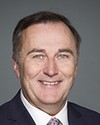Okay. I will start at the very macro level. I will also recommend to my colleague when Brigadier-General Misener comes that perhaps he can submit an actual graphic through the clerk.
It would show that, which will help everybody to understand.
Very quickly, they are going to find out. You have a problem, you go to the doctor. I will use myself, because we can't breach my confidentiality if I use it. I'm bicycling home. I have an accident. I break my collarbone. I have to go to the medical clinic because I now have a broken collarbone. This immediately results in a restriction on my ability to do activities. I would go through that process of physiotherapy or all the normal things anyone would go through.
If I'm okay, then I'm returned to full duties. If it turns out I've had a complication, then I would go from a temporary medical category to a potential review for what we call a permanent medical category.
That is the policy decision that says this medical category may put you in breach of universality of service. You're not even necessarily at the JPSU yet. You may be there because of your circumstance, or you may not be.
Once that permanent medical category decision is made, you're then on track for a medical release. I will let Brigadier-General Misener speak to that process because that's the core transition piece, but at the end of the day you are certainly engaged both by SISIP and by Veterans Affairs prior to your medical release.
For comment on the offsets of incomes—because the income aspect is complex—I will let Manulife speak to that.



